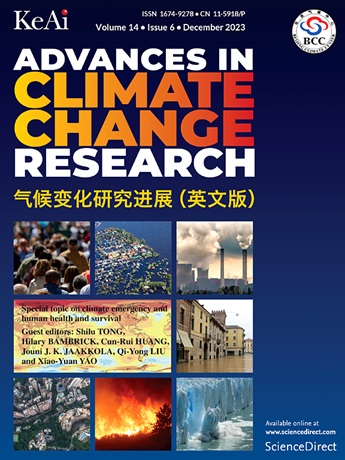青藏高原积雪持续时间和积雪深度对全球变暖的不一致响应模式
IF 5.2
1区 地球科学
Q1 ENVIRONMENTAL SCIENCES
引用次数: 0
摘要
积雪具有较高的反照率和保温性能,对气候变化的影响很大,对气候变化的响应也很快,特别是在青藏高原。该地区低纬度和强烈太阳辐射的结合进一步放大了气候变化对积雪的影响。在春季和夏季,气候变化驱动的积雪模式变化引发了水文循环的转变,影响了淡水供应和植被生长。然而,由于在不同时期使用了不同的数据集,以往调查青藏高原积雪变化的研究得出了不一致的结果。通过对比1990 - 2019年青藏高原春夏季积雪时长(SCD)和积雪深度(SD)变化趋势,分析青藏高原积雪对气候变化的响应模式。基于这两个参数变化的空间分布,我们将区域划分为积雪时长和雪深同时增加的区域(SCD+SD+)、积雪时长增加而雪深减少的区域(SCD+SD−)、积雪时长减少而雪深增加的区域(SCD−SD+)和积雪时长和雪深同时减少的区域(SCD−SD−)。气温上升正在推动低海拔地区从降雪到降雨的转变,而高海拔地区仍主要处于冰点以下,限制了这种转变。通过分析4个地区的气温和降水变化,我们发现春夏季海拔4700 m以上地区积雪时长对全球变暖的响应有限,春季降雪量的增加主导了积雪时长的整体上升。相比之下,在低海拔地区观测到的积雪持续时间的减少主要归因于变暖效应,而不考虑降雪的变化。春、夏季积雪深度变化主要受冬季降雪趋势的影响。此外,负趋势(p <;(p <;0.05)的夏季温度。该研究有助于理解气候变化和海拔高度共同作用下积雪变化的复杂性和不一致性。本文章由计算机程序翻译,如有差异,请以英文原文为准。
Inconsistent response patterns of snow cover duration and snow depth over the Tibetan Plateau to global warming
Snow cover possesses high albedo and thermal insulation properties, greatly influencing climate change and responding rapidly to climatic variation, particularly on the Tibetan Plateau. The region's combination of low latitude and intense solar radiation further amplifies the effects of climate change on snow cover. During the spring and summer seasons, changes to snow cover patterns driven by climate change initiate shifts in hydrological cycles, affecting freshwater availability and vegetation growth. However, previous studies investigating snow cover changes across the Tibetan Plateau have yielded inconsistent results due to the use of diverse datasets across varying periods. This study aims to analyze the response patterns of snow cover to climate change on the Tibetan Plateau by comparing trends in snow cover duration (SCD) and snow depth (SD) during spring and summer from 1990 to 2019. Based on the spatial distribution of changes in these two parameters, we categorized regions into four distinct types: areas where both snow cover duration and snow depth increase (SCD+SD+), areas where snow cover duration increase while snow depth decreases (SCD+SD−), areas where snow cover duration decrease while snow depth increases (SCD−SD+), and areas where both snow cover duration and snow depth decreases (SCD−SD−). Rising temperatures are driving a shift from snowfall to rainfall in lower-altitude regions, while high-altitude areas remain predominantly below freezing, limiting this conversion. By analyzing temperature and precipitation changes in the four areas, we observed that the response of snow cover duration to global warming is limited at altitudes above 4700 m during spring and summer, with an increases in spring snowfall dominating the overall rise of snow cover duration. In contrast, the declines in snow cover duration observed in lower-altitude areas are primarily attributed to warming effects, regardless of variations in snowfall. The snow depth variation is mainly influenced by winter snowfall trends during spring and summer. Furthermore, the negative trends (p < 0.05) in summer snowfall are mainly influenced by the increase (p < 0.05) summer temperatures. The study aids in understanding the complexity and inconsistencies of snow cover changes under the combined effects of climate change and altitudes.
求助全文
通过发布文献求助,成功后即可免费获取论文全文。
去求助
来源期刊

Advances in Climate Change Research
Earth and Planetary Sciences-Atmospheric Science
CiteScore
9.80
自引率
4.10%
发文量
424
审稿时长
107 days
期刊介绍:
Advances in Climate Change Research publishes scientific research and analyses on climate change and the interactions of climate change with society. This journal encompasses basic science and economic, social, and policy research, including studies on mitigation and adaptation to climate change.
Advances in Climate Change Research attempts to promote research in climate change and provide an impetus for the application of research achievements in numerous aspects, such as socioeconomic sustainable development, responses to the adaptation and mitigation of climate change, diplomatic negotiations of climate and environment policies, and the protection and exploitation of natural resources.
 求助内容:
求助内容: 应助结果提醒方式:
应助结果提醒方式:


